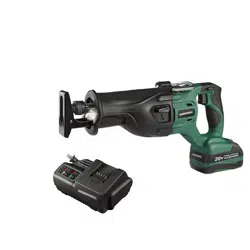Loading ...
Loading ...
Loading ...

Page 11
OPERATION
GENERAL CUTTNG
WARNING:
Before attaching the
battery pack to the tool, always check
to determine that the switch performs
properly and returns to the “OFF” position
when released.
WARNING:
Hold the tool only by
the plastic handle and the insulated grip
area to help prevent electrical shock.
When sawing into walls or oors you may
encounter electrical wiring. Sawing into a
“live” wire will cause electric shock.
1. Remove the battery pack from the saw.
2. Make sure that the workpiece is firmly
clamped.
3. Use the appropriate type and size of
blade for the workpiece material and size.
4. Adjust the pivot shoe as necessary to make
sure that the blade will extend beyond the
shoe and the workpiece at all times.
5. Adjust the pivot shoe as necessary to
expose unworn blade teeth for longer
blade life.
6. Check for clearance behind the
workpiece so that the blade will not
impact another surface.
7. Mark the line of cut clearly. If cutting
metal, see METAL CUTTING section.
8. Attach the battery pack to the saw.
9. Hold the saw firmly with both hands.
Make sure to keep your hands on the
insulated gripping areas only.
10. Open the lock-off button and press
the trigger switch to start the saw and
bring it to the maximum desired cutting
speed before applying the blade to the
workpiece.
11. Do not force the tool. Place the shoe
firmly on the workpiece while cutting.
Use only enough steady pressure on the
blade to keep the saw cutting.
12. Reduce pressure as the blade comes to
the end of the cut.
13. Allow the saw to come to a complete
stop before removing the blade from the
workpiece.
14. If sawing fiberglass, plaster, wallboard,
or spackling compound, clean the saw
motor vents frequently with a vacuum
or compressed air. These materials are
highly abrasive and may accelerate the
wear on motor bearings and brushes.
WARNING:
Always wear safety
goggles or safety glasses with side
shields during power tool operations, or
when blowing dust.
NOTICE: Cutting speeds should vary with
the workpiece. Hard materials, such as
metals, require lower speeds; for softer
materials use higher speeds.
PLUNGE CUTTING (FIG. 8)
A B
FIG. 8
Your reciprocating saw is ideal for plunge
cutting directly into surfaces that cannot be
cut from an edge, such as walls or floors.
Plunge cutting may be done two ways,
depending on how the blade is inserted.
Column A shows how to plunge cut with the
teeth of the blade facing down. Column B
shows how to plunge cut with the teeth of
the blade facing up.
1. Insert the blade into the tool. If the
blade is inserted with the teeth facing
downward, hold the tool as shown in
Column A, resting the edge of the shoe
on the workpiece.
2. If you inserted the blade with the teeth
facing upward, hold the tool as shown in
Column B, resting the edge of the shoe
on the workpiece as shown.
3. With the blade just above the workpiece,
depress the trigger switch, and using
the edge of the shoe as a pivot, lower
the blade into the workpiece.
Loading ...
Loading ...
Loading ...
